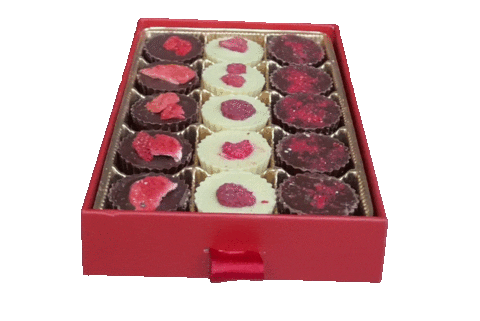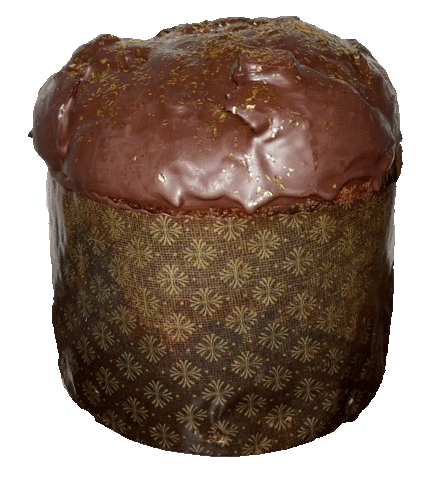Why It Feels So Good To Eat Chocolate
7:36 minutes

When you eat a piece of good chocolate, chances are you don’t just bite down and chew away. There’s a good chance you hold the chocolate in your mouth for a moment, feeling the silkiness as it softens, melting into a molten mass and mixing with your saliva. That gradual phase change process—as fats in the chocolate melt from solid to liquid—is a big part of the chocolate mouthfeel experience.
Researchers at Leeds University in the UK have constructed an artificial tongue that doesn’t focus on the taste of a food, but rather its texture, and how that texture changes over time. Using the artificial tongue, they explored the textures of materials that can change phase in the mouth, such as chocolate, butter, and ice cream.

They reported their findings recently in the journal ACS Applied Materials & Interfaces. The researchers found that in dark chocolate, the sensation in the mouth is governed largely by the fat content, as the surface of the chocolate begins to soften. A few moments later, as the chocolate melts completely and mixes with saliva, the fat content of the treat is less important to the mouthfeel experience.
Dr. Anwesha Sarkar, an author of the report, joins Ira to talk about the research, the challenge of designing a lower-fat chocolate that might exploit these findings, and the importance of learning about textures to determine why people like—and don’t like—certain foods.
Invest in quality science journalism by making a donation to Science Friday.Donate To Science Friday
Dr. Anwesha Sarkar is a professor of Colloids and Surfaces in the School of Food Science and Nutrition at the University of Leeds in Leeds, UK.
Ira Flatow
This is Science Friday, I am Ira Flatow. Maybe you have some chocolate leftover from Valentine’s Day or you’ve picked some up when it went on sale the day after? Good move. Well, go grab a piece right now if you have one because for the rest of the hour, we’re talking about how chocolate makes you feel. And no no no, I’m not talking about loved or happy, but the actual physics of how it feels in your mouth, because that’s part of the secret of enjoying chocolate, isn’t it? Joining me now is Dr. Anwesha Sarkar. She’s a professor of colloids and surfaces at the University of Leeds and Leeds, UK. Her group recently wrote about this phenomenon in the journal ACS, Applied Materials and Interfaces. Welcome to Science Friday.
Anwesha Sarkar
Thank you so much, Ira, for having me.
Ira Flatow
You’re welcome. Now I know your team developed a sort of artificial tongue, not not so much to taste the samples but to investigate the feel of the food.
Anwesha Sarkar
Exactly, to understand the friction. What happens in the mouth? What more from a textural perspective?
Ira Flatow
And why is that important?
Anwesha Sarkar
So you know, most of the aversion for food, if you think, or of liking actually comes from texture, which is much, much less studied. We always say about taste. But food is much more than that. So we developed this tongue to really understand the physics, what goes on in the mouth when you rub up against a surface and chocolate happens to be the fun material to work with.
Ira Flatow
All right, let’s get right into that. If I take a bite of chocolate, what’s going on with the chocolate in my mouth?
Anwesha Sarkar
With the premium chocolates, what do you do? So, you just don’t chew, chew chew. You put it in your mouth, either you lick it against your tongue, like appreciate the feel, and then gradually and gradually it starts melting in your mouth. So it’s a phase change materials, it melts in your mouth. But this whole process happens in a couple of seconds. So what we did in our study was to understand this process to dissect this few seconds into exactly what happens in the mouth. So when you put the chocolate in your mouth, when you rub it against your tongue, when it melts, when it mixes with saliva, what are the exact things that goes on? And why for example, fat matters. Does it matter, the content of fat? And so on.
Ira Flatow
Well tell us, what what did you find happening? What happens? Take us through the the steps of what’s going on in your mouth with the initial feel, and then the melting and so on.
Anwesha Sarkar
So what we did is we took dark chocolate as a model, and then with different fat content. And then we rubbed it against this artificial tongue. And what we realized was very interesting. So when you take the chocolate in your mouth, it’s just a first step. That is where it matters the most, the calorie content. That we see, there is a very interesting difference in friction between 70% fat chocolate versus 90% fat chocolate. But after that, when it has started melting and mixing with saliva, it’s actually saliva drives the game. So you don’t see so much of the calorie content affecting. Of course, you need those fats to create the feel, but it matters less as compared to the initial touch.
Ira Flatow
So if I wanted to optimize that silky feel, would I front load the fat content into the surface of the piece?
Anwesha Sarkar
In principle, yes, exactly. So there it matters way more to think about the silky mouthfeel, to think about the right texture of what you create for. Versus in the body, it matters less. As maybe the protagonist, there is much more saliva driven rather than the fat driven.
Ira Flatow
Now I know that you did not invent a new chocolate. You your work was done using off the shelf chocolate samples from the store. But how easy would it be to engineer a chocolate with the properties that you would like? Is it as simple as have a low fat piece and dip it in a shell of fattier stuff? Or how difficult is it?
Anwesha Sarkar
Yeah, that will be the obvious one, isn’t it? To create a clear kind of material. But you know, if you if you look at the history of chocolate making, it will be difficult because it is made from cocoa beans and stuff and a lot of flavoring material come in that picture. But if you see how old manufacturing is evolving, we have 3d printing now. So there are a lot of things that’s going on in terms of the technology. So imagine a situation where we are printing our chocolate in the way we want at our home. So that is the kind of you know, utopia, it seems like at the moment but it’s not. It’s like in few years down the line, we will have that and we had that actually in manufacturing in many countries. The other thing to think about is that there are also a lot of chocolates which are not made with cocoa butter like composites and compound fat, vegetable fat and so on, where we can make a lot of changes in the process to make those kinds of chocolate which has a much more outer surface layer of fat versus inner. But again I want to stress, we did not make a chocolate. So it’s going to be an interesting challenge to take, of course.
Ira Flatow
If mouthfeel, as you talk about it, if the texture is so important for that first bite of food, does your tongue know this? Is it specially equipped to feel the texture as well as taste it?
Anwesha Sarkar
So this is very interesting and also if you think of the tongue, it’s a muscular material, but it has a lot of features. And if I make it very simple, you have fungiform papillae which contain taste buds, and the filiform papillae which does not contain any taste buds, and they are much more numerous in the number. So these features in the in the mouth, they are just there for speech and for friction and for detecting texture. So how cool is that?
Ira Flatow
That is cool.
Anwesha Sarkar
So I think a lot of um studies needs to be there in this area to understand texture and how does texture contribute to liking a food. We know it does contribute to disliking. People don’t like, you know, mushy material, for example. It’s all linked to texture rather than taste. It can still be sweet, but the texture matters.
Ira Flatow
Are there other foods that this research applies to as well?
Anwesha Sarkar
So we said it will definitely the mechanisms which we propose will apply to phase change materials like like ice cream, like cheese, and so on. But we need more work to understand whether it can be applied to other section of food which is non-phase change material itself. But at the moment, we have only looked at phase change material like chocolate or ice cream, which contains some amount of fat as a key ingredient.
Ira Flatow
That’s crazy to learn that most of the papillae in the tongue have no taste buds, but are are there for touch. So if we know this now, and our listeners have that piece of chocolate that I asked them to get, and they want to try this for science, how should they taste their chocolate sample?
Anwesha Sarkar
So they should taste their chocolate sample like the way it is. But just close your eyes and don’t think about sweetness, please. Don’t say it’s just sweet. That’s the last thing I want to hear.
Ira Flatow
You want to hear how it feels?
Anwesha Sarkar
Exactly! That’s correct.
Ira Flatow
Dr. Sarkar, thank you for joining us today.
Anwesha Sarkar
Thank you very much.
Ira Flatow
Dr. Anwesha Sarkar. She’s a professor of colloids and surfaces. Yes, that exists. In the School of Food Science and Nutrition at the University of Leeds in Leeds, UK. And that’s about it for today. If you missed any part of the program, you’d like to hear it again, subscribe to our podcasts or ask your smart speaker to play Science Friday. And of course you can say hi to us on social media all week long: Facebook, Twitter, Instagram. Or if you’d like to contact us the old fashioned way, our address is scifri@sciencefriday.com. Have a great weekend. We’ll see you next week. I’m Ira Flatow.
As Science Friday’s director and senior producer, Charles Bergquist channels the chaos of a live production studio into something sounding like a radio program. Favorite topics include planetary sciences, chemistry, materials, and shiny things with blinking lights.
Ira Flatow is the founder and host of Science Friday. His green thumb has revived many an office plant at death’s door.